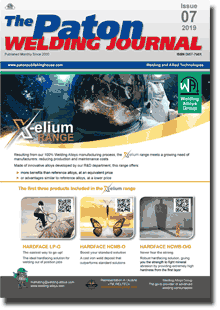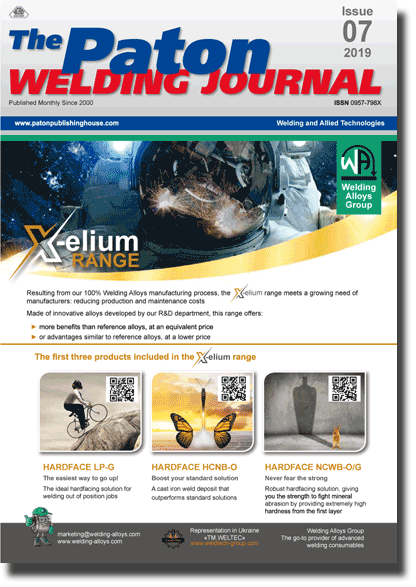| 2019 №07 (07) |
DOI of Article 10.15407/tpwj2019.07.08 |
2019 №07 (09) |

The Paton Welding Journal, 2019, #7, 36-40 pages
Journal The Paton Welding Journal
Publisher International Association «Welding»
ISSN 0957-798X (print)
Issue #7, 2019 (July)
Pages 36-40
Flux-cored wire for restoration surfacing of worn surfaces of railway wheels
V.D. Poznyakov, A.A. Gajvoronsky, A.V. Klapatyuk, A.S. Shishkevich and V.A. Yashchuk
E.O. Paton Electric Welding Institute of the NAS of Ukraine 11 Kazimir Malevich Str., 03150, Kyiv, Ukraine. E-mail: office@paton.kiev.ua
Research was performed and flux-cored wire of PP-AN180MN/98 grade was developed for restoration surfacing of worn areas of advanced higher-strength railway wheels. A set of physicomechanical properties of the deposited metal was determined. It is found that at application of PP-AN180MN/98 wire for surfacing higher-strength wheels, irrespective of preheating temperature and number of deposited layers, deposited metal hardness is optimum (0.94–1.0 of rail hardness). Here, a comparatively homogeneous bainite-martensite structure forms in all the joint areas (in the deposited metal, fusion zone and overheating area of HAZ metal). The deposited metal features a high level of resistance to brittle fracture and wear at sliding friction in contact with rail steel. Obtained research results lead to the conclusion that at application of flux-cored wire PP-AN180MN/98 for surfacing, the restored wheels will have a high reliability, and traffic safety will be ensured under the conditions of increasing operating loads. 17 Ref., 5 Tables, 4 Figures.
Keywords: electric arc surfacing, railway wheel, flux-cored wire, structure, mechanical properties, brittle fracture, wear
Received: 31.05.19
Published: 24.07.19
References
1. Uzlov, I.G. (2003) Advanced processes of production and quality of railway wheels. Stal, 5, 69–72 [in Russian].2. Railway wheels and tires KLW. Interpipe NTZ Ukraine, www.interpipe.biz [in Russian].
3. Vakulenko, I.O., Anofriev, V.G., Gryshchenko, M.A., Perkov, O.M. (2009) Defects of railway wheels. Dnipropetrovsk, Makovetsky [in Ukrainian].
4. Babachenko, A.I., Kononenko, A.A., Dementieva, Zh.A. et al. (2010) Examination of causes of defect formation on roll surface of high-strength wheels in operation. Zaliznychny Transport Ukrainy, 5, 35–38 [in Russian].
5. Ostash, O.P.,Andrejko, I.M., Kulyk, V.V., Prokopets, V.I. (2011) Contact-fatigue damage of roll surface of railway wheels of KP-2 and KP-T type. Visnyk DNUZT, 39, 118–122 [in Ukrainian].
6. (1998) Resource-saving technologies of repair of railway engineering using welding, surfacing and spraying. Trudy VNIIZhT. Ed. by V.N. Lozinsky. Moscow, Intellect [in Russian].
7. Gajvoronsky, A.A., Poznyakov, V.D., Markashova, L.I. et al. (2012) Influence of deposited metal composition on structure and mechanical properties of reconditioned railway wheels. The Paton Welding J., 8, 16–22.
8. Uzlov, I.G., Babachenko, A.I., Dementieva, Zh.A. (2005) Influence of microalloying of steel on fracture toughness of railway wheels. Metallurgiya i Gornorudnaya Promyshlennost, 5, 46–47 [in Russian].
9. Babachenko, A.I., Litvinenko, P.L., Knysh, A.V. et al. (2011) Improvement of chemical composition of steel for railway wheels providing increase of their resistance to defect formation on roll surface. In: Fundamentals and Applied Problems of Ferrous Metallurgy: Transact. of IFM, 23, 226–233 [in Russian].
10. Ivanov, B.S., Filipov, G.A., Demin, K.Yu. et al. (2007) Modification of wheel steel by nitrogen. Stal, 9, 22-25 [in Russian]. https://doi.org/10.3103/S0967091207090112
11. Rybakova, L.M., Kuksenova, L.I. (1982) Structure and wear resistance of metal. Moscow, Mashinostroenie [in Russian].
12. Artemov, I.I., Savitsky, V.L., Sorokin, S.A. (2004) Modeling of wear and prediction of tribosystem life. Penza, PSU [in Russian].
13. (1972) New methods of evaluation of metal resistance to brittle fracture. Ed. by Yu.N. Robotnov. Moscow, Mir [in Russian].
14. Panasyuk, V.V. (1991) Mechanics of quasibrittle fracture of materials. Kiev, Naukova Dumka [in Russian].
15. GOST 25.506: Methods of mechanical tests of metals. Determination of characteristics of crack resistance (fracture toughness) at static loading.
16. Efimenko, M.G., Radzivilova, N.O. (2003) Physical metallurgy and heat treatment of welded joints. Kharkiv, NTU KhPI [in Ukrainian].
17. Ryabtsev, I.I., Chernyak, Ya.P., Osin, V.V. (2004) Block-module installation for tests of deposited metal. Svarshchik, 1, 18–20 [in Russian].
Suggested Citation
V.D. Poznyakov, A.A. Gajvoronsky, A.V. Klapatyuk, A.S. Shishkevich and V.A. Yashchuk (2019) Flux-cored wire for restoration surfacing of worn surfaces of railway wheels. The Paton Welding J., 07, 36-40.The cost of subscription/purchase order journals or individual articles
| Journal/Currency | Annual Set | 1 issue printed |
1 issue |
one article |
| TPWJ/USD | 384 $ | 32 $ | 26 $ | 13 $ |
| TPWJ/EUR | 348 € | 29 € | 24 € | 12 € |
| TPWJ/UAH | 7200 UAH | 600 UAH | 600 UAH | 280 UAH |
| AS/UAH | 1800 UAH | 300 UAH | 300 UAH | 150 UAH |
| AS/USD | 192 $ | 32 $ | 26 $ | 13 $ |
| AS/EUR | 180 € | 30 € | 25 € | 12 € |
| SEM/UAH | 1200 UAH | 300 UAH | 300 UAH | 150 UAH |
| SEM/USD | 128 $ | 32 $ | 26 $ | 13 $ |
| SEM/EUR | 120 € | 30 € | 25 € | 12 € |
| TDNK/UAH | 1200 UAH | 300 UAH | 300 UAH | 150 UAH |
| TDNK/USD | 128 $ | 32 $ | 26 $ | 13 $ |
| TDNK/EUR | 120 € | 30 € | 25 € | 15 € |
AS = «Automatic Welding» - 6 issues per year;
TPWJ = «PATON WELDING JOURNAL» - 12 issues per year;
SEM = «Electrometallurgy Today» - 4 issues per year;
TDNK = «Technical Diagnostics and Non-Destructive Testing» - 4 issues per year.


